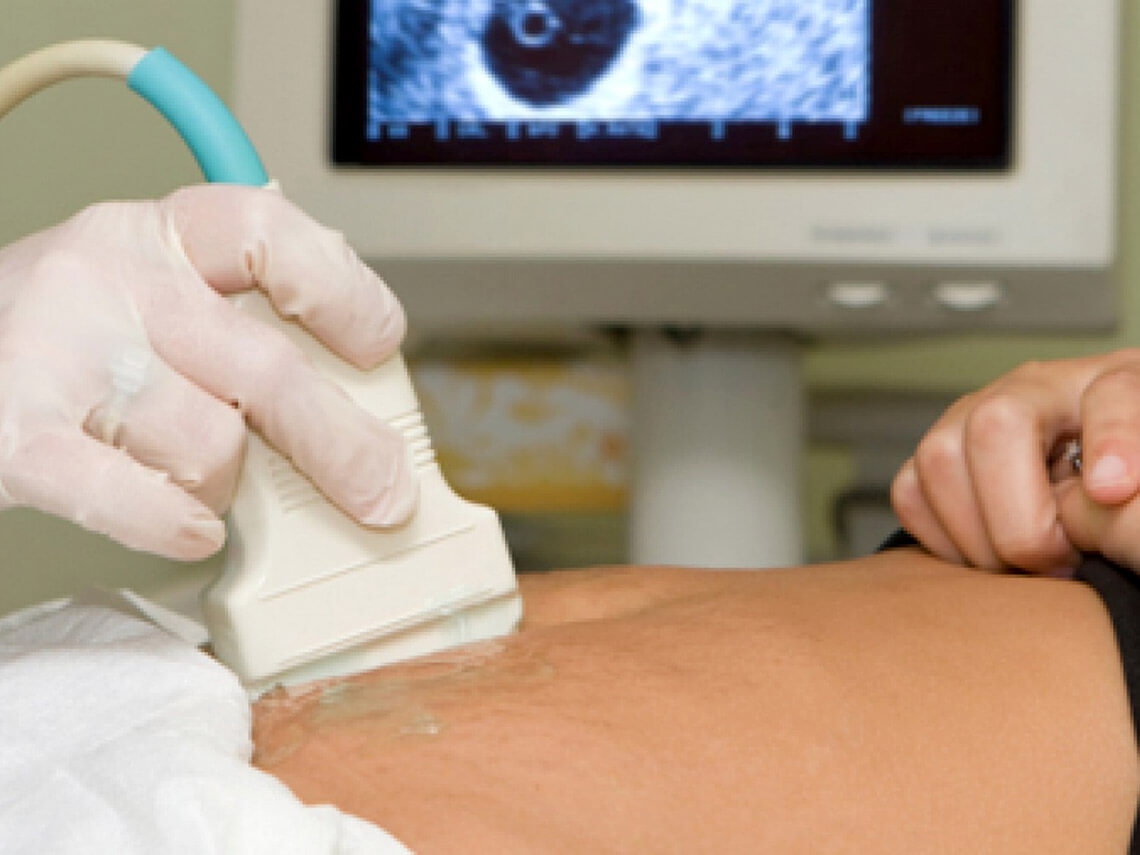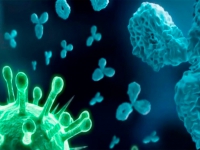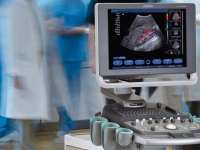Basic principles of ultrasound diagnosis of tumors:
- Primary tumors of the organs and metastases have the form of limited formations, the shape, and echo-structure of which is characteristic of tumors.
- The normal structure and echo structure of the affected organ is changed or completely disrupted.
Ultrasound picture of tumors:
- Benign and malignant tumors of different organs may have different criteria of malignancy (for example, an echogenic contour is a sign of metastasis in the liver, but also a sign of benign nodule in the thyroid gland)
- Calcifications and thinning can occur in both benign and malignant tumors.
- For many types of tumors, there are no reliable criteria for malignancy
Ultrasound revealed changes in the organs:
- Direct ultrasound imaging of some tumors is difficult, but they can be detected indirectly, due to the effects created on the affected organ.
- Changes in the affected organ are primarily related to changes in its contours and echo structure, but they can also affect blood vessels and tubular structures.
Related changes:
- Sometimes the clinical significance of tumors is due not to their primary location or changes in the affected organ, but the relationship with neighboring structures and the impact on them.
- Tumors can cause clinical manifestations by altering motor processes (eg, intestinal peristalsis), the formation of pathological fluid accumulations, impaired patency of blood vessels or other tubular structures, or infiltration of tangential organs.
Ultrasound criteria of malignance:
The appearance of tumors:
- Form:
- Scallops (pancreatic carcinoma)
- Round (hepatocellular carcinoma)
- Spotted (cholangiocellular carcinoma)
- Polygonal, ribbon-shaped or target (colorectal carcinoma)
- Echogenicity:
- Metastases usually have a rounded shape and reduced echogenicity, but multiple metastases are prone to fusion (liver metastases)
- Colorectal cancer metastases are usually hyperechoic, often with a hypoechoic circuit, more often multiple than single.
- Hemangiomas are more likely to be metastases. At the same time, the feeding vessel or vessels in a tumor (that is not characteristic of metastases) come to light
- Degenerative changes:
- Dilution:
- Foci of thinning can occur in both benign and malignant tumors, such as metastases of colorectal cancer, atypical hemangiomas, and metastases of breast cancer.
- Carcinoid metastases can be diagnosed by their large anechoic areas and hyperechoic circuit.
- Calcinates:
- Microcalcinates - can be formed in old metastases in the liver, testicular, and prostate cancer.
- Macrocalcinates - can form in metastases of colorectal cancer, renal cell carcinoma, primarily hepatocellular carcinoma and hemangiomas.
- Differential diagnosis:
- Echogenic air bubbles that give acoustic shadow or reverberation (can mimic calcifications)
- Echogenic calcifications of the abscess with distal shadow enhancement.
- Dilution:
- Benign tumors with a contour
- Liver adenoma, focal nodular hyperplasia, hemangioma: due to the displaced tissue and blood vessels may form a pseudo capsule (rare)
- Abscess: hyperechoic pyogenic membrane. Occasionally, abscesses may have a hypoechoic cortex.
- Malignant tumor with contour:
- Primary carcinoma:
- Hepatocellular carcinoma: the occurrence of a hypoechoic circuit is considered uncharacteristic.
- Renal cell carcinoma: vascular circuit on the periphery, internal vessels.
- Metastases: there is a stable hypoechoic contour (a sign of "halo"), respectively, the zone of the intensive proliferation of tumor cells. Metastases of colorectal cancer can sometimes show a sign of a non-permanent contour (halo); this feature does not allow to differentiate metastases of colorectal cancer from hemangiomas.
- Primary carcinoma:
The nature of vascularization:
- To date, there are no reliable ultrasound indicators of differential diagnosis of benign and malignant tumors. This may be due to differences in the types of tumor angiogenesis and changes in the ascending nature of organ vascularization.
- Types of vascularization of benign tumors:
- Liver adenoma: hypervascularization
- Focal nodular hyperplasia: hypervascularization with the typical nature of vascularization by the type of "wheel spokes"
- Leiomyoma, GIST tumors: no visible intra-tumor
- Vessels Types of vascularization of malignant tumors: depends on the type of tumor and the affected organ. No specific type of vascularization was identified for specific tumors (although liver tumors may show typical variants in different phases of contrast ultrasonography: early arterial, arterial, venous, and portal venous). Three types of vascularization have also been identified, often accompanying malignancies (according to Tanaka):
- Branched type: observed in hepatocellular carcinoma and other tumors (lymph nodes, in which vascularization of the "spoke needle" type is common)
- Type "basket", or "spokes of wheels": hepatocellular carcinoma with peripheral vascularization
- Spotted type: the most common type of angiogenesis, with a high probability, indicates a malignant process. The presence of tumor arteries is a sign of malignancy.
- Organ changes:
- Changes in contours: protrusions, inequalities
- Changes in the contours of tubular structures: tumor invasion, obstruction, or displacement of tubular structures (eg, blood vessels, bile ducts).
- Vascular deformity or infiltration: portal vein with portal hypertension and hepatic veins in Budd-Chiari syndrome.
- Related changes:
- Functional disorders:
- Obstruction of the bile ducts (tumors of the bile ducts, pancreas, stomach).
- Obstruction of the urinary tract (tumors of the female genital organs, intestine, urothelial carcinoma)
- Cavity vein obstruction
- Obstruction of the duct of the pancreas (pancreatic carcinoma, benign microcystic cystadenoma)
- Partial or complete intestinal obstruction (tumors of the urogenital tract, gastrointestinal tumors, pancreatic impressions with intra-abdominal metastases, infiltration, or carcinomatosis of the peritoneum).
- Local-regional metastases
- Pathological fluid accumulations:
- Pleural effusion (metastases to the pleura)
- Ascites:
- limited (with progressive tumors of the gallbladder, tumors of the urogenital region or intestine)
- generalized (with peritoneal carcinomatosis, liver metastases)
- differential diagnosis of benign and malignant ascites:
- Benign ascites (anechoic) (internal echo signals, membranes), free movement of fluid, smooth, with a smooth contour of the peritoneum, thin abdominal omentum, loosely spaced mesentery, a sign of "sea anemone", a thin mobile wall of the intestine. Characteristics of liver cirrhosis, pancreatitis, right gastric insufficiency.
- Malignant ascites (anechoic) (internal echoes, membranes), limited (divided into chambers, encapsulated), thick rigid large omentum, tightened mesentery, connecting loops of the intestine, thickened rigid wall of the intestine, joints between the intestine, anterior and anterior lymph nodes and liver. Characteristics of metastases and tumors of the intestine, pancreas, uterus, and ovaries.
Displacement, fixation, and infiltration:
Bias:
- Organs (kidneys, spleen or stomach due to tumors of the liver, intestine, and pancreas)
- Vessels and tubular structures (cavity vein, with the development of superior or inferior vein syndrome)
Fixation:
- Stomach and intestines
- Serous membranes (peritoneum, pleura)
Infiltration:
- Tangential organs (bile ducts, spleen, kidneys, stomach)
- Serous membranes (peritoneum, pleura)
- Vessels (cavitary vein due to liver metastases in bronchial carcinoma, tumors of the kidneys, portal vein, splenic vein, and peritoneal trunk carcinoma of the pancreas)
- Cavities of internal organs (bladder, gallbladder) by tumors of the gastrointestinal tract or urogenital tract.
For the final diagnosis, it is necessary to carry out CT or MRI with contrast, PET CT.







